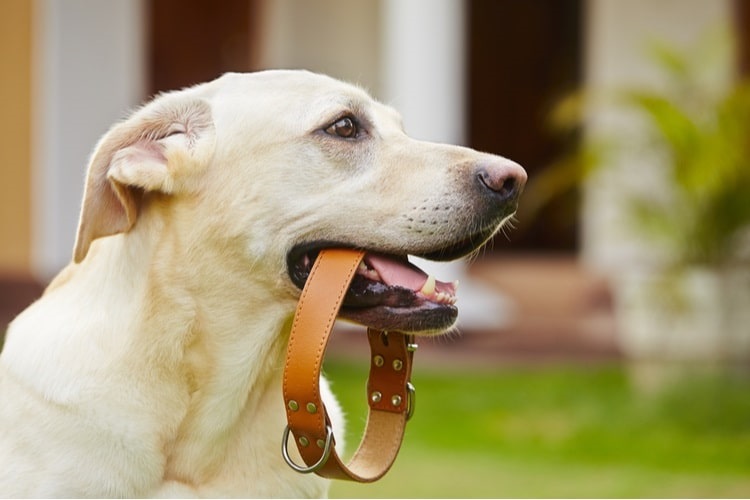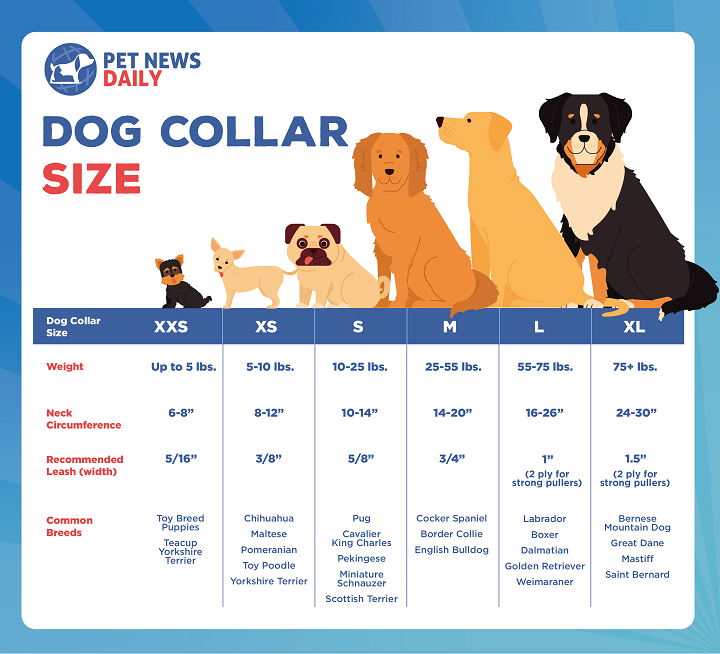Your favorite furry pooch needs a new collar. Or maybe you’re new to pet parenting and stocking up on the appropriate pet supplies for your soon-to-be furry family member. Either way, a dog collar is a must. And though you may have thought about the type, color, or design of the new collar, outfitting your dog with the right size is essential.
With so many dog collars out there to choose from, we created a dog collar size chart for your convenience. We consulted our veterinarian, Dr. Jennifer Coates, to guide us through the data, which she reviewed and approved. Since a dog’s weight and actual size are highly individual, Dr. Coates strongly recommends using the two-finger approach as the ultimate method for accurate sizing. “Two fingers should fit under a dog’s collar to ensure a comfortable but snug fit,” she advises.
In This Article
Different Types of Dog Collars
Just as all dogs are different, dog collars come in a wide variety of styles, lengths, and materials. Here’s a rundown of dog collars available to you, your best and worst options, and which type might suit your needs.
Recommended:
- Standard buckle or snap-on dog collar – When most people think of a dog collar, the simple, flat nylon collar is usually the first one that comes to mind. Made with different types of buckles, these collars fit most dogs and come in a large range of styles, widths, colors, and patterns. Other standard flat dog collars are made with materials such as leather, canvas, and polyester.
- Round collar – Round collars are another version of the standard collar. But instead of the collar being flat, the material is rounded.
- GPS collar – A GPS collar uses global positioning satellite technology to keep tabs on your pooch’s whereabouts. The collar is typically designed like the standard collar, except a GPS device is attached to the strap.1
In some circumstances:
- Head collar – The head collar features multiple straps to fit around both the back of your dog’s head and muzzle. This type of collar is a training collar for dogs who pull or are leash reactive. Many dogs don’t like wearing a head collar, and it may not be suitable for all dogs.23
- Martingale collar – A cross between a standard collar and choke collar, the Martingale collar offers safety while acting as a non-slip collar. Adjusted and used correctly, the collar tightens slightly around your dog’s neck, without choking, should your dog try to back out of the collar while on the leash. It’s also made for dogs with narrow heads who can easily slip out of a standard collar.45
- Breakaway collar – A breakaway collar does just that: it breaks away if excessive force is put on the collar. This can be good or bad depending on the situation.6
- Slip collars and leads – A slip lead is typically a long, looped leash that functions as a handle, leash, and collar all-in-one. Not recommended for most, this type of collar or lead is usually used by animal rescues and shelters due to the ease of slipping it around a nervous dog’s neck.7
Not Recommended:
- Choke collar – A choke collar is usually made out of a metal chain, which tightens automatically when the collar is pulled, either by the dog, leash, owner, or an object it gets tangled on. Using a choke collar is never recommended since it can lead to serious injury and sometimes death.89
- Shock or electric collar – This type of collar delivers an electric shock from a transmitter that is triggered when the dog exhibits a behavior the owner wants to correct. Made illegal in multiple countries as a device of abuse, the shock collar is commonly used with electric fencing. The electric collar is not recommended since it causes pain, can lead to injury and can make behavior worse.1011
- Prong collar – A prong collar is also a choke collar, only it’s made with steel prongs that push into your dog’s neck when the collar is tightened. The prongs can cause short- and long-term injury.1213
- Spray collar – This type of dog collar sprays either air or citronella into your dog’s face to deter him from barking. Spray collars are not recommended as they often malfunction and can increase unwanted behavior.14
How to Choose the Right Collar
With all the different types of dog collars available, how do you know which one and what size to get your dog? The majority of dogs do well with standard dog collars, which come in a variety of sizes. However, small dogs and those with tracheal issues are better suited for a harness.15 Standard dog collar sizes range from extra, extra small to extra large, fitting breeds from Chihuahuas to Saint Bernards. Ultimately, as our veterinarian has stressed, using the two-finger rule is your best bet for the right fitting collar.
Alternatively, consider using a harness (you can consult our list to see the best escape proof dog harness) instead of, or as well as, a collar as your primary attachment for a leash (read our review of the Rabitgoo escape proof dog harness). Harnesses reduce the risk for injury to the neck and spine and also aid in leash training. For dogs who pull, a harness that clips in the front or front and back discourages the dog from pulling. Harnesses are often more effective for training your dog to walk nicely on a leash.16
We’ve created a series of dog collar buying guides with specific collars recommended by our veterinary advisors including our list of the best dog collars, guide to choosing the best cute dog collar, and list of the best collars for Poodles.
Dog Collar Size Chart
Our dog collar size chart can help you determine the best collar size for your dog based on neck circumference or weight. If you’re looking for a dog collar size chart in cm, it’s easy to convert the measurements below. There are 2.5 centimeters in an inch, so simply multiply the measurements in inches from the chart by 2.5. Or, you can use this handy converter to convert inches to centimeters.
Share This Dog Collar Size Chart on Your Site
Text Transcript of Dog Collar Size Chart
| Dog Collar Sizes | Dog Weight | Neck Circumference | Recommended Leash | Common Breeds |
|---|---|---|---|---|
| XX SMALL X SMALL SMALL MEDIUM LARGE X-LARGE |
Up to 5 lbs. 5-10 lbs. 10-25 lbs. 25-55 lbs. 55-75 lbs. 75+ lbs. |
6 – 8″ 8 – 12″ 10 – 14″ 14 – 20″ 16 – 26″ 24 – 30″ |
5/16″ width 3/8″ width 5/8″ width 3/4″ width 1″ width, 2 ply for strong pullers 1.5″ width, 2 ply for strong pullers |
Toy Breed Puppies & Teacup Yorkshire Terrier Chihuahua, Maltese, Pomeranian, Toy Poodle, Yorkshire Terrier Cavalier King Charles, Pekingese, Miniature Schnauzer, Pug, Scottish Terrier Border Collie, Cocker Spaniel, English Bulldog Boxer, Dalmatian, Golden Retriever, Labrador Retriever, Weimaraner Bernese Mountain Dog, Great Dane, Mastiff, Rottweiler, Saint Bernard |
How to Measure for a Dog Collar
One easy way to determine what size collar your dog needs is to measure your dog’s neck. Fortunately, it’s pretty easy to do. Grab a flexible tape measure or piece of string to record his neck circumference. Gently place the measuring tape or string against your dog’s neck and comfortably wrap it around the thickest part of his neck. If you’re using string, mark the string and measure it taut against a ruler for an accurate reading. This number will give you a baseline to work with.
You can also check out our post on how tight a dog collar should be to determine the right tightness for your dog’s collar.
Dog Collar Size by Weight (with Calculator)
The best way to outfit your dog with a new collar is to measure his neck. Then, check your measurement against our handy chart. Take into consideration his weight and breed, and then try the recommended collar size on your dog. Adjust the strap using the two-finger rule to create the perfect fit for your pooch.
For example, a Labrador’s collar size will more than likely be a large. Neck circumference typically grows with a dog and usually, the more a dog weighs, the larger the neck. A medium dog collar size typically fits breeds such as Cocker Spaniels and Border Collies, whose neck circumference measures anywhere from 14 inches to 20 inches.
Also included in our dog collar size chart are recommendations for appropriate leash widths for various size dogs.
Wondering how big your puppy might get as he grows? Check out our dog adult weight calculator below. Keep in mind that there are several factors that can influence a dog’s weight, and because all dogs are individuals, your dog’s weight may not match the estimates for his breed. The best way to monitor your dog’s growth is with the help of your veterinarian, who can determine if your dog is at a healthy weight considering factors such as his health history, diet, and exercise.
The calculations for the weight calculator are based on the American Kennel Club’s database of adult dog weights and heights. Fill in your new puppy’s current age, weight, and other details below.
Note: please don’t feed your dog more or less based on the results. For that advice, consult your veterinarian.
PUPPY WEIGHT CALCULATOR
Article Sources
Pet News Daily uses only high-quality sources, including peer-reviewed studies, to support the facts within our articles. Read our editorial process to learn more about how we fact-check and keep our content accurate, reliable, and trustworthy.
- Dog Collars. Humanesociety.org. Accessed February 16, 2022.
- Dog Collars. Humanesociety.org. Accessed February 16, 2022
- Head Collars and No-Pull Harnesses. Positively.com. Accessed February 16, 2022.
- AKC Staff. The Best Collars and Leashes for Puppies and Dogs. Akc.org. Published October 25, 2019. Accessed February 16, 2022.
- Dog Collars. Humanesociety.org. Accessed February 16, 2022.
- Miller P. The Safest Types of Dog Collars (and the Most Dangerous). Whole-dog-journal.com. Published November 10, 2017. Accessed February 16, 2022.
- Dog Collars. Humanesociety.org. Accessed February 16, 2022.
- Choke and Prong Collars. Positively.com. Accessed February 16, 2022.
- Dog Collars. Humanesociety.org. Accessed February 16, 2022.
- Shock Collars. Positively.com. Accessed February 16, 2022.
- Dog Collars. Humanesociety.org. Accessed February 16, 2022.
- Choke and Prong Collars. Positively.com. Accessed February 16, 2022.
- Dog Collars. Humanesociety.org. Accessed February 16, 2022.
- Dog Collars. Humanesociety.org. Accessed February 16, 2022.
- AKC Staff. The Best Collars and Leashes for Puppies and Dogs. Akc.org. Published October 25, 2019. Accessed February 16, 2022.
- Head Collars and No-Pull Harnesses. Positively.com. Accessed February 16, 2022.


